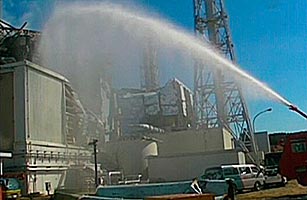
Could there at last be a flicker of good news from Japan? On Saturday, Japanese officials announced that last-ditch efforts to stabilize the crippled Fukushima Daiichi
nuclear power plant that was damaged by the March
11 earthquake and tsunami might be achieving a modicum of success. Engineers said they had connected a power cable to the plant, possibly allowing pumps to begin flowing water into cooling pools surrounding dangerously overheating
nuclear fuel rods and spent fuel containers. The operation will only work, however, if the pumps were not too damaged by the earthquake. So far, two of the reactor’s power cables have been re-established, that of Nos. 1 and 2 out of a total of six.
Still the threat level from the damaged plant remains very high. Of particular concern is reactor No. 3, where a spent nuclear fuel pool is reaching high heat levels. If fuel rods or spent fuel gets too hot, it can
explode or otherwise send radioactive matter into the air. So far, the plant has already suffered explosions and fires, sending gusts of radioactivity into the atmosphere. On Saturday afternoon, trucks mounted with
high-pressure water cannons continued to spray streams of ocean water on the reactors in order to lower the temperature. Firefighters swathed in radioactive-protection gear rushed in to refuel the trucks, exposing themselves to a highly radioactive environment.
The hazardous work went on as Tokyo Electric Power Company , which operates the plant, announced that it was more than doubling the maximum amount of radiation exposure each worker could endure, from 100
millisieverts to 250. The International Commission on Radiological Protection advises that exposure for nuclear workers should not exceed 50 millisieverts per year.
A TEPCO spokesman said that another crucial operation was to create holes in the roofs of reactors No. 5 and 6 because of an alarming build up of hydrogen gas, which could cause an explosion. But even as TEPCO workers
raced to carry out various complicated maneuvers to stabilize the plant, an official at Japan’s
nuclear safety agency said that the electric company had not properly protected the back-up generator system for the
nuclear power plant — a particularly worrying fact given that the area in which it is located is prone to earthquakes and tsunamis. After the back-up system was deluged by a tsunami on March 11, pumps needed to cool the reactors stopped operating, precipitating the current emergency.
Meanwhile, the Yomiuri Shimbun, Japan’s largest daily newspaper, reported that the Japanese government had rejected an American offer to help tackle the nuclear crisis in the hours following the calamitous earthquake and
tsunami because the offer was “premature.” According to the Yomiuri report, “the U.S. offer was apparently rebuffed because the government and Tokyo Electric Power Co. — the plant’s operator — were confident the reactors’ cooling functions could be repaired without outside assistance.” Since then, American planes have been allowed to monitor radiation levels around the plant and U.S. firetrucks have been shipped in to help with the nuclear
cooling effort.
After the Kobe earthquake struck the country’s southwest in 1995, killing 6,400 people, Japan was criticized for not allowing foreign aid in quickly enough. Government officials have said they have fixed this failing, and that aid and advice have flowed in more efficiently this time. But still some major snags remain, as the Yomiuri report proves.
Separately, Japan’s
Chief Cabinet Secretary
Yukio Edano announced
on Saturday that higher-than-normal amounts of radiation were found in milk and spinach that came from areas within 100 km of the Daiichi plant. But Edano insisted that the radiation amounts found in the food posed “no immediate health risk.” In
Tokyo, where a 6.1 magnitude earthquake struck
on Saturday evening, further spooking residents, grocery stores had experienced a run on dairy products. At one shop in central Tokyo, a sign read: “We apologize for
the lack of milk, but for the safety of our customers, we are declining to stock milk at this time.” The region around the nuclear plant is one of Japan’s major farm belts, producing vegetables, dairy and meat. With the
wind blowing some of the radiation being emitted from the plant over the
Pacific Ocean, there’s also a concern that fish, a major part of the Japanese diet, will be tainted. Miniscule amounts of
radioactive iodine were found in Tokyo tap water on Saturday. News of contaminated water further spooked a capital that has been unnaturally quiet since the March 11 quake and tsunami. Earlier in the week, the air in Tokyo, less than 250 km from the Daiichi plant, showed elevated levels of radiation in the air, sending some residents in doors. Efforts to conserve energy have left escalators paused and neon signs darkened. An exodus of foreigners from Tokyo has gathered pace as foreign embassies helped citizens secure plane flights. Even some Japanese, usually an implacable people, have headed out of town.
Meanwhile, a heart-warming story aired on Japanese T.V. stations about a man pulled out of the tsunami rubble 8 days after the wave struck turned out to be false. In fact, the man from Kesennuma town was a survivor who had gone back to his demolished home and had curled up on a blanket in the rubble, only to find himself the subject of an impromptu rescue. By
Saturday afternoon, the confirmed death toll of the March 11 disaster was 7,300, with another 11,300 missing — but that number is sure to climb. These days, good news is hard to come by in Japan. See TIME’s complete coverage of the Japan earthquake.
See TIME’s Top 10 Everything of 2010.